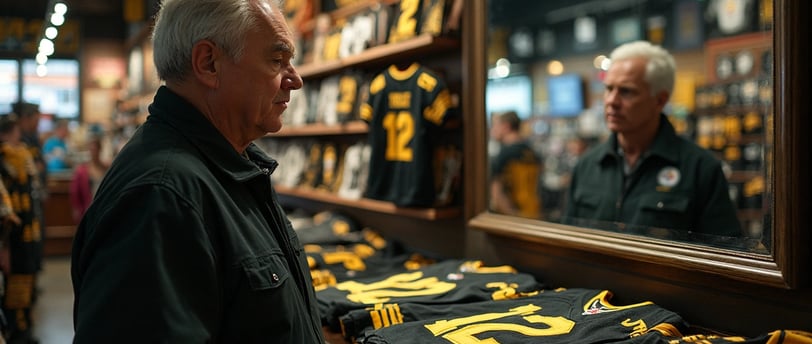Steelers News: The Real Cost of Aaron Rodgers - Drop in Steeler Brand Value
The Steelers' latest move to sign Rodgers looks like their biggest gamble in years. Rodgers threw for 3,897 yards and 28 touchdowns last season. But his Jets stint raises red flags - he won just five games and left them with $49 million in dead money.
6/6/20257 min read


The Steelers' latest move to sign Rodgers looks like their biggest gamble in years. Rodgers threw for 3,897 yards and 28 touchdowns last season. But his Jets stint raises red flags - he won just five games and left them with $49 million in dead money.
The merchandise sales look promising right now for Pittsburgh's marketing team. Local businesses report growing demand for Rodgers gear, which helps short-term revenue. But this 21-year veteran brings a controversial image to a team that hasn't won a playoff game since 2016. The Steelers need to think over a crucial question: Will the buzz from Rodgers' signing hurt their decades-old brand values more than it helps? The immediate attention might not be worth the risk to their reputation.
The Rodgers Effect on Steelers Marketing
Aaron Rodgers' deal with the Steelers has sent waves through Pittsburgh's merchandise market. The ripples started even before he signed on the dotted line. His arrival affects not just jersey sales but the whole Steelers' business ecosystem.
Original merchandise buzz
Rumors about Rodgers joining the Steelers got buyers excited. "It's huge, I think everyone is on the fence about the Steelers right now," said Tim Piett, who manages "Yinzers in the Burgh" in the Strip District. Stores started getting calls about Rodgers' gear as soon as word got around. This excitement marks a big change from what Piett calls "lukewarm lately" business from locals.
People didn't wait to start buying. A Pittsburgh visitor shared, "My boyfriend really likes Aaron Rodgers and, apparently, he's signing tomorrow with the Steelers. Had to buy him a sticker". Even small items with Rodgers' name flew off the shelves based on rumors alone.
Delay in official branding rollout
The long wait between Rodgers and the Steelers created big headaches for merchandise planning. "Everything is on hold because we don't know what the situation is going to be," Piett explained. Stores couldn't prepare for what could be a golden chance to boost sales.
The Steelers made it official on June 5 after months of speculation. Retailers can now start what Piett calls "the fast track" for merchandise production. Items should hit the shelves in about a week.
The jersey number situation makes things tricky. Rodgers wore #12 most of his career but switched to #8 with the Jets. Many fans think of #12 as "sacred" since Hall of Famer Terry Bradshaw wore it, though it's not officially retired.
Effect on local Pittsburgh businesses
Pittsburgh retailers see Rodgers as their ticket to better sales after years of average team results. Local businesses struggled to keep fans excited about Steelers merchandise with no playoff wins since 2016. Rodgers' arrival could change everything overnight.
"Yinzers in the Burgh" shows how the whole Pittsburgh market feels. Their story proves how one player can refresh an entire business community in a football-crazy city. They went from getting occasional calls to constant questions about Rodgers' merchandise.
This signing comes at just the right time for Pittsburgh's marketing efforts. City businesses dealt with many quarterback changes - Rodgers will be the fifth starting quarterback in as many years for the Steelers. Building a solid marketing plan was tough with so many changes, but Rodgers' star power gives businesses a fresh chance to succeed despite the uncertainty.
Brand Identity Crisis: Is Rodgers a Fit?
Aaron Rodgers' arrival in Pittsburgh means way beyond just football strategy—it challenges the very identity of the Steelers organization. Mixed reactions from fans and former players point to an identity crisis brewing within one of the NFL's most stable franchises.
Rodgers' controversial public image
Rodgers comes with plenty of off-field drama that worries many Steelers fans. His darkness retreats, psychedelic drug use, and frequent appearances on talk shows clash with Pittsburgh's blue-collar culture. The fans have real concerns about his personality disrupting team chemistry. "Toxic locker room, that's what I'm worried about," one supporter pointed out. His age raises questions about his commitment to the team, as another fan put it bluntly, "I'm unhappy because he's kind of old".
Conflict with Steelers' traditional values
Rodgers' style and Pittsburgh's organizational philosophy couldn't be further apart. While Rodgers says he appreciates the Steelers' "family-business feel and stability", doubts remain about how well he fits. Former Steelers star Ryan Clark didn't mince words, calling this signing the "worst-case scenario for Pittsburgh Steelers fans" and adding it "continues to keep you mired in mediocrity". Coach Tomlin's run-first philosophy clashes with Rodgers' style—he threw the second-most passes in the NFL last season. The team's move to get deep threat DK Metcalf doesn't match Rodgers' recent stats. He ranked 32nd out of 36 qualified quarterbacks with just 6.6 air yards per attempt last season.
Fan discomfort with jersey number debate
The jersey number debate perfectly shows this cultural divide. The Steelers haven't officially retired #12, but no player has worn it since Terry Bradshaw retired in 1983. Bradshaw blasted both the Steelers and Rodgers, calling the team a "joke" for pursuing him. "It better be #8 because #12 is 'sacred'" one fan insisted about Rodgers' number choice. Some fans took extreme measures to protest—one burned his signed Minkah Fitzpatrick jersey and declared "I'll never be a Steelers fan again".
Short-Term Hype vs. Long-Term Value
Pittsburgh's bet on a one-year deal with Aaron Rodgers brings quick rewards but leaves many wondering about where the franchise is headed. This move shows how teams struggle to balance quick wins against their long-term reputation
Spike in media attention and ticket sales
The Steelers got back into the spotlight with a one-year investment of less than $20 million. The team's popularity changed dramatically from March when KDKA "struggled to find a single person who was excited about Rodgers". These days, fans believe he's "one of the only free agent quarterbacks who gives us a Super Bowl ceiling".
The Steelers didn't bring Rodgers just to keep their non-losing season streak going for an NFL-record 22 years. They made this move because "they feel they, and he, can win playoff games". ESPN analyst Booger McFarland put it clearly: "They're not bringing in Aaron Rodgers here to go 9-8... they're going to get a 41-year-old quarterback... to see if he can have some similar effect that Tom Brady had in Tampa".
Risk of alienating loyal fanbase
The move split Steelers Nation right down the middle. Fans had mixed reactions:
"It's about time"
"I feel really good"
"I'm unhappy because he's kind of old"
"I'll never be a Steelers fan again"
Former Steelers star Ryan Clark didn't hold back. He called this "the worst-case scenario for Pittsburgh Steelers fans" and predicted the team will "probably be home Week 1 of the playoffs and again be looking for a franchise quarterback". The team risks losing long-time fan support just to grab some quick attention.
No clear succession plan post-Rodgers
Rodgers might play well, but at 41, he's just a temporary solution. The team seems lost without a real quarterback strategy. Rodgers will be "the sixth starting quarterback for the Steelers since Ben Roethlisberger's retirement". The team passed up chances to draft future stars like Jordan Love and Jalen Hurts.
The Steelers plan "to acquire a long-term answer at the position in 2026". Rodgers serves as a quick fix. Building a team's reputation around such uncertainty might keep the playoff drought going even longer than 2016.
Building a Brand Around Uncertainty
The Steelers organization faces unique marketing challenges as they build their franchise identity around a 41-year-old quarterback with a one-year contract. Their experiment with Rodgers forces them to rethink brand management strategies that could alienate die-hard fans through mixed messaging.
Challenges in consistent messaging
The Steelers' marketing team confronts a tough challenge. Creating coherent messaging around a player's temporary situation seems nearly impossible. Rodgers' one-year deal makes long-term promotional planning a complex puzzle. The organization must now guide what sports branding experts call "the delicate balance between legacy and innovation".
Ryan Clark, a former NFL star, expressed this problem clearly when he called the Steelers' approach a continued acceptance of "mediocrity". This creates a messaging paradox - promoting Rodgers as the franchise face while preparing fans for his eventual departure.
Balancing legacy with short-term gains
Stability and consistency have always defined the Steelers' brand. The question now emerges
whether short-term relevance justifies risking our decades-old identity. Critics describe Rodgers as a "washed-up, 41-year old, finger pointing, blame deflecting DIVA". His personality clashes with our blue-collar image.
Sports marketers call this "a pivotal chapter" for franchise identity. The team must balance immediate performance benefits against future brand promises. A branding expert notes, "The brand of a sports team is its DNA; the brand is the way that a team presents itself to stakeholders and the public".
Lessons from other NFL branding missteps
NFL teams offer valuable lessons through their branding errors:
Columbus Crew SC's failed rebrand - Fan backlash forced the team to restore "Crew" to their name after 3,000 petition signatures.
NFL scandal management - League controversies show that "when one player makes a mistake... the public almost always points fingers at the NFL".
These precedents remind us that "sports leaders must try to understand how fans feel about the rebranding before making significant changes". The Steelers' tradition-based brand takes a substantial risk by pursuing short-term gains with Rodgers.
Conclusion
The Brand Value Equation: Final Thoughts
A complete analysis of the Rodgers acquisition shows a franchise at a crossroads. Without doubt, the instant marketing buzz brings welcome relief after years of playoff drought. In spite of that, this temporary surge comes at a heavy cost to our 90-year old brand identity.
Steelers fans value stability, blue-collar work ethic, and long-term thinking. Building our brand around a 41-year-old controversial figure with a one-year contract challenges these core principles. The jersey number debate shows how quickly this move has split our fanbase.
Quick wins matter. The merchandise sales, media attention, and fresh excitement deserve recognition. These benefits need careful weighing against what could harm the Steelers' special character. Ryan Clark's warning about continued "mediocrity" raises serious concerns.
Our organization faces a tough balancing act. We must boost Rodgers' marketing value during his stay. The team needs a solid plan for his eventual exit. Most crucial of all, we must protect the core values that have shaped Steelers football through generations.
This gamble could lead to a deep playoff run and justify the temporary transformation. It might also speed up our brand erosion and leave us hunting for both a new quarterback and our lost identity in 2026. The Rodgers experiment will mark a defining moment for our franchise.
Aaron Rodgers' real cost goes way beyond his contract value. The final price might be measured in something more precious – the Steelers' brand identity itself.


